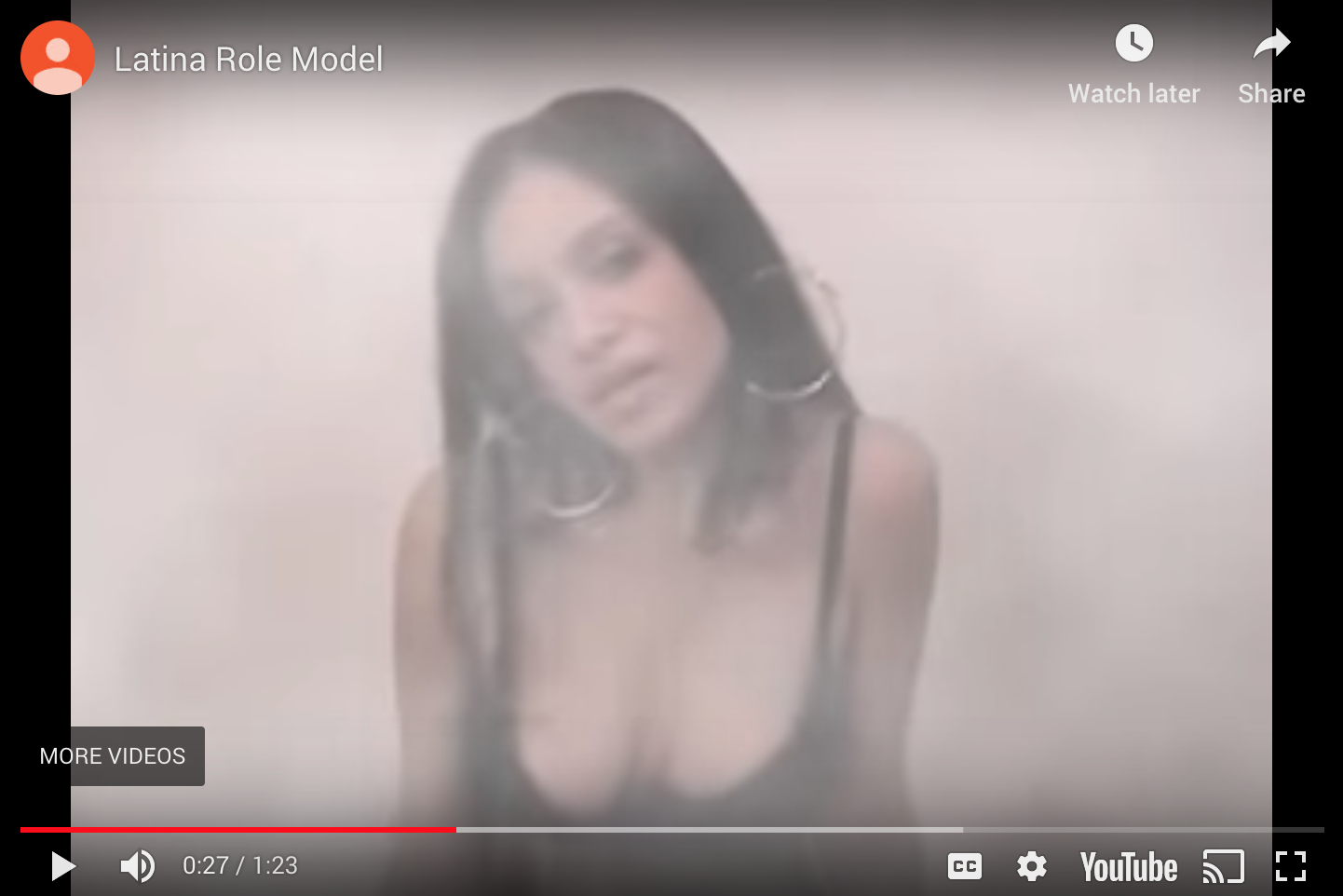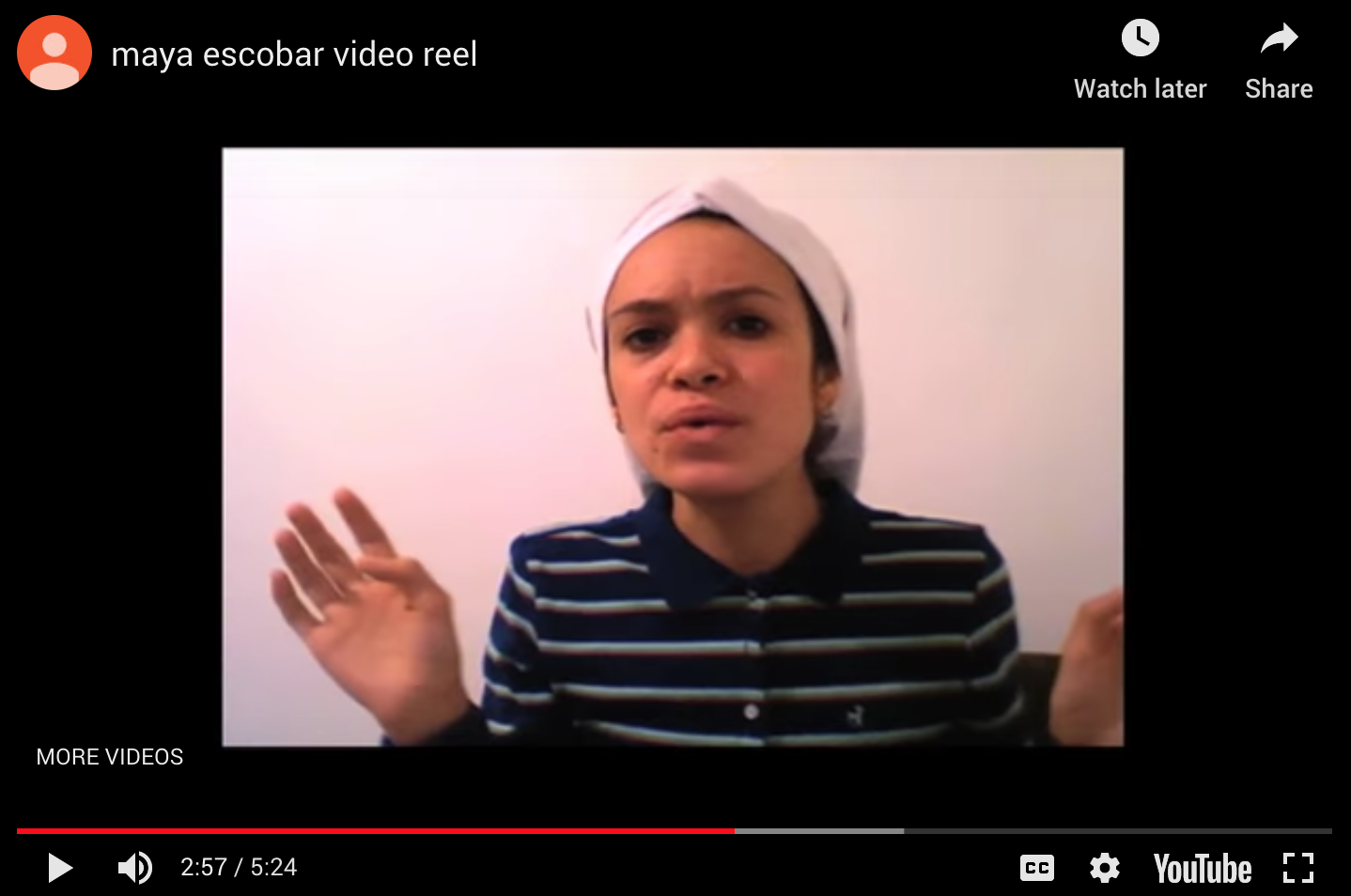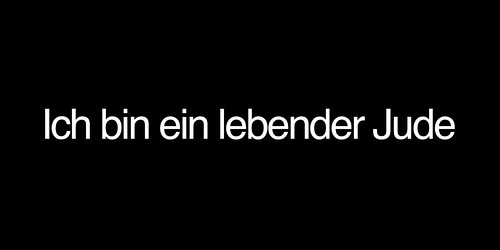[youtube=http://www.youtube.com/watch?v=aicKK2IkQzg][youtube=http://www.youtube.com/watch?v=6wyLF3DXK4I]
Artista disléxica del Internet
Por David Sperber en Ma’arav Israeli Arts and Culture MagazineTraducción de Gonzalo Escobar (de Traducción de Shlomit Nehorai)Maya Escobar es sin ninguna duda una de las personas más de moda en el desarrollo del arte judío-estadounidense. Escobar se define como “artista disléxica del Internet”. Y para ver su trabajo uno no necesita ir muy lejos.Su trabajo es creado principalmente en el formato familiar del Internet, y se puede ver más frecuentemente en Youtube. Escobar es hija de madre Judía y de padre Guatemalteco, ella define su trabajo personal y versátil de arte como una investigación antropológica-sociológica dentro de la narrativa que utiliza medios electrónicos contemporáneos.Acciones Plásticas incluye películas de corto metraje que presentan una serie de caracteres persuasivos y monólogos en los que se cuestiona la identidad. En la primera película de corto metraje de la serie aparece, vestida como la artista mexicana Frida Kahlo quien se convirtió en un ícono dentro del discurso feminista. Se argumenta comúnmente que Kahlo tenía algunas raíces judías. Escobar aparece vestida como Kahlo con sus famosas cejas mientras que grita “Yo soy Frida Kahlo. Usted es Frida Kahlo. Nosotros somos Frida Kahlo”. En agitación o en éxtasis se desgarra su ropa, se despeina, se quita el maquillaje y vuelve a ser ella misma.[youtube=http://www.youtube.com/watch?v=xlMPoFXRT18]
En la otra película de corto metraje de la serie, ella continúa con un monólogo de una mujer ortodoxa judía. El texto aquí es tan exacto que por un minuto la línea entre la ironía y la comedia burda y la seriedad profunda es borrosa.[youtube=http://www.youtube.com/watch?v=8H8mpau6dSc]En otra película de corto metraje se presenta el estereotipo de mujer latina como objeto sensual sexual, cuando aquí el tema se desenvuelve también entre la aprobación y la destrucción de los estereotipos. Escobar presenta diversos episodios basados en la realidad que ella misma ha experimentado enfocados en su identidad híbrida como mujer, como judía y como latinoamericana.[youtube=http://www.youtube.com/watch?v=F_1X1igrL4U]Otro trabajo de Escobar es My Shtreimel (Mi sombrero de peluche judío de Europa Oriental) - un vídeo-blog que también se puede encontrar en Youtube. En esta sección aparece un joven de más de veinte años que está sentado frente a una computadora y habla de sus rituales del Shabbat (el día de descanso para los judíos). El monólogo describe un mundo judío amorfo en el cual la esencia judía viva y material no es obligatoria a sus instituciones, sobre todo en el marco personal. Una parte central en este mundo es la auto depreciación de uno mismo: El joven muestra su querido shtreimel y menciona que el shtreimel que se ve como el sombrero tradicional es realmente un sombrero de mujer comprado en una tienda de segunda.
En el trabajo “eruv”* (entremezclarse) Escobar relata el hecho que en Berlín no hay ningún eruv aun cuando allí existe una comunidad judía vibrante. En una serie de entrevistas fotografiadas con los habitantes de la ciudad ella transforma la noción del eruv - en una noción legal halajá (recopilación de las principales leyes judías) que crea una transformación del espacio público en el espacio privado, en una mezcla - la creación múltiple de caracteres y de mundos. El eruv se transforma en un concepto cultural que celebra lo diferente y lo único. Los individuos crean un mosaico espléndido que ensambla un grupo “colectivo” diferente como concepto social. La forma en que Escobar trata el tema es típico al mundo judío-estadounidense del arte que tiende a transferir los conceptos del halajá práctico y para transferirlo a otro mundo, y así se transforma en una metáfora de la condición personal o social. La experiencia personal es significativa a Escobar. Como otros rituales judíos, el Shabbat abarca los sentidos prácticos que materializan la condición privada en un espacio privado. Excepto que el entendimiento del espacio privado y del espacio público es fluido y cambia siempre. Yo pienso que es muy importante de que la gente celebre su Shabbat como experiencia agradable, definida y personal. Los rituales del Shabbat evolucionan con el tiempo - no como obligación inamovible que se transfiere de generación en generación, pero como resultado de una opción simple del individuo de crear él/ella las mismas costumbres agradables de Shabbat. Todos tenemos esta clase de costumbres.”El uso intercontinental del Internet dio a luz a una generación de individuos que crean algo solo por el hecho de crear algo, y el concepto del crear arte por el hecho del crear arte consigue de esa manera un nuevo significado. Los medios de comunicación del Internet conectan a individuos y contribuyen mutuamente a entrelazar a la gente que trabaja por separado en lugares lejanos. El trabajo nuevo del Internet desafía las viejas definiciones en lo referente a lo qué se considera arte y a lo que no es. De igual manera, adopta nuevas formas de la presentación que no son la norma en la corriente principal del mundo del arte, y le revigoriza al campo del arte.La discusión del trabajo de Escobar conduce a una discusión más amplia sobre las diferencias entre el pensamiento judío en la conversación israelita en la nueva comprensión de la opinión estadounidense del mundo. El compromiso judío-artístico en los Estados Unidos está influenciado por la introducción de las ideas de la nueva era en el centro de la conversación, y está integrando en el esfuerzo de crear una conexión entre la cultura contemporánea y la identidad judía tradicional. Dentro de la comunidad estadounidense-judía hay muestras de un movimiento de una expresión judía institucional organizada en una expresión única y personal de experiencias muy personales. Estos artistas que reorganizan las tradiciones en sus propios términos, y de esta manera contribuye no insignificantemente a la definición Ortodoxo-Moderno No-Ortodoxo Judío-Estadounidense nuevamente. El acoplamiento entre la cultura judía y la identidad judía al arte ocupa un papel central en esta conversación.Los ecos de esta tendencia se pueden encontrar también en Israel (por ejemplo, en la cultura joven de Yiddish {idioma hablado por los judíos de Europa Oriental} en Tel Aviv), pero generalmente todavía hay una desconexión profunda entre los conceptos dominantes en Israel y en los Estados Unidos. En Israel es común la conexión entre el judaísmo con una tradición organizada y con el linaje o la línea de sangre y la consanguinidad basada en una continuidad genética. Por otra parte, muchos judío-estadounidenses jóvenes se casan fuera de su religión, pero sin embargo ellos se ven como parte integral del mundo judío y saben que no serán expulsados por esto. En comparación con los israelíes que experimentan su identidad judía en términos de desintegración que siguió la restauración, los judío-estadounidenses crean nuevas ramas donde las metáforas del crecimiento y del renacimiento se acoplan mejor.La unión de la cultura y del arte contemporáneos a la creatividad judía se expresa en características de moda como tatuajes, música hip-hop, arte del Internet y otras formas similares, y se entiende a menudo como la desconexión con la dicotomía dualista aceptada entre lo sagrado y lo mundano. Esto es porqué los tradicionalistas consideran estas formas de arte como provocación peligrosa. La interconexión cultural de estos nuevos conceptos durante discusiones desafiantes con los viejos conceptos culturales. Filológicamente hablando se puede decir que pedir prestados símbolos a partir de una disciplina a otra interfiere con los sistemas semióticos. En el lenguaje Cabalístico (kabbalah o cábala es una de las principales corrientes de la mística judía) se dice que la energía creada durante la fricción producida por la desintegración de las cosas va a crear generalmente “nueva luz”.* De acuerdo a la religión judía durante el Shabbat lo judíos no pueden hacer ningún trabajo, ni tampoco llevar cosas fuera de sus casas o de las murallas de su ciudad. Cuando la ciudad o pueblo no tiene murallas, se tiene que construir un “eruv”, que es una construcción de cables y postes para así poder marcar los límites físicos del pueblo y esto se convierte en una estructura virtual imaginaria.
Berlin's Eruv at the 2009 Conney Conference on Jewish Art
I will be presenting Berlin's Eruv at the 2009 Conney Conference: Performing Histories, Inscribing Jewishness at University of Wisconsin Madison. Berlin’s Eruv is a conceptual project that addresses the assumed non-presence of Jews in Germany. Berlin does not actually have an eruv. There is however, an active Jewish community, one that is frequently overshadowed by the city's prominent monuments and memorials commemorating Jewish life (death). Berlin's Eruv weaves together voices from Berlin's Jewish community in an attempt to construct a metaphorical eruv representative of a living Jewish Community. Just as the eruv exists in the minds of the people who abide by it, Berlin’s Eruv manifests itself through the conversations surrounding the idea of the piece.*****I will be showing Berlin's Eruv at 2009 MFA Thesis Exhibition, opening May 8th at the Kemper Art Museum.
Berlin’s Eruv is a conceptual project that addresses the assumed non-presence of Jews in Germany. Berlin does not actually have an eruv. There is however, an active Jewish community, one that is frequently overshadowed by the city's prominent monuments and memorials commemorating Jewish life (death). Berlin's Eruv weaves together voices from Berlin's Jewish community in an attempt to construct a metaphorical eruv representative of a living Jewish Community. Just as the eruv exists in the minds of the people who abide by it, Berlin’s Eruv manifests itself through the conversations surrounding the idea of the piece.*****I will be showing Berlin's Eruv at 2009 MFA Thesis Exhibition, opening May 8th at the Kemper Art Museum.
Frida Kahlo at the synagogue: Maya Escobar
Frida Kahlo at the synagogue: Maya Escobar and the young Jewish-American Creationby David Sperber in Ma'arav Israeli Arts and Culture Magazine.translation by Shlomit NehoraiARTICLE IN SPANISH & HEBREWMaya Escobar is no doubt one of the 'hottest' things developing in the Jewish-American art scene. Escobar defines herself "dyslexic internet artist". And in order to view her work you need not wander far.Her work is mostly created in familiar internet format, and is most often displayed on Youtube. Escobar, daughter to a Jewish mother and Guatemalan father, defines her art work as ongoing personal anthropological-sociological research into the narrative language that uses contemporary media.[youtube=http://www.youtube.com/watch?v=3li_mT--f-A]The "Acciones Plasticas" work includes short films that present a series of convincing characters and monologues that deal with identity questions. In the first short film in the series she appears dressed up as the Mexican artist Frida Kahlo who became an icon within the feminist discourse. it is commonly argued that Kahlo had some Jewish roots. Escobar is dressed and made up as is famously attributed to Kahlo - the uni brow - while screaming "I am Frida Kahlo, you are Frida Kahlo, we are Frida Kahlo". In agitation or in ecstasy she tears her custom, messes up her hair, wipes her make up off of her face and returns to being herself. In another short film in the series she carries on with a monologue of a jewish orthodox woman. The text here is so exact that for a minute the line between irony and slapstick to deep seriousness is blurred. In another short film the stereotypical Latin female as a sexual sensual object is presented, when here too the subject is moving between embracing the stereotypes and breaking them. Escobar is presenting different episodes that she had experienced herself and that deal with her hybrid identity as a woman, as a Jew and as a Latin American.[youtube=http://www.youtube.com/watch?v=NNAxEUEE43Y]
Another work of Escobar is "my shtreimel" - a video-blog that is also presented on Youtube.In that piece appears a young man in his twentieths who sits in his room in front of a computer and talk about his Shabbat rituals. The monologue describes an amorphous jewish world in which jewishness lives and materializes without obligation to its institutions and mostly in personal frameworks. A central part in this world is self deprecation: The young man shows his beloved shtreimel and mentions that the shtreimel which looks like the traditional is actually a women's hat purchased at a thrift store.
In the work "eruv" (intermingling) Escobar relates to the fact that in Berlin there is no eruv even though there exists a vibrant jewish community. In a series of photographed interviews with the city's citizens she transforms the notion eruv - from a halachic-legal notion that creates a conversion of the public space into the private space, into a blending - the creation of a multiple of characters and worlds. The blending (eruv)transforms into a cultural concept that celebrates the different and the unique. The individuals create a splendid mosaic that assembles anew the "collective" as a social concept. The way Escobar deals with the subject is typical to the jewish-american art world that tends to transfer concepts from the practical halachic and transfer them to another world, and so they transform into a metaphor of the personal or social condition. The personal experience is significant to Escobar: " Like other jewish rituals, the Shabbat encompasses practicalities that materialize private condition in a private space. Except that the understanding of the private space and the public space is fluid and changes at all times. I think that it is very important that people celebrate their Shabbat as a pleasant experience, defined and personal. The Shabbat rituals evolve all the time - not as an unbending obligation that is transferred from generation to generation, but as a result of a simple choice of the individual to create to him/herself nice and pleasant Shabbat customs. We all have these kind of customs."The intercontinental use of the Internet gave birth to a generation of individuals who create for creation's sake, and the concept of art for art's sake gets that way a new meaning. The Internet media connects individuals and contributes to mutual influences between people who work separately in far away places. The young work on the Internet challenges the old definitions in relation to what is considered art and what isn't. Similarly, it adopts new presentation forms that are not the norm in the art world's mainstream, and breathes new air into the art field.The discussion into Escobar's work leads into a wider discussion about the differences between the Jewish thinking in the Israeli discourse into the new understanding of the American world view. The Jewish-artistic engagement in the United States is influenced by the introduction of new-age ideas into the center of the conversation, and is integrating into the effort to create a connection between contemporary culture and the traditional Jewish identity. Within the American-Jewish community there are signs of a move from an organized institutional Jewish expression into a unique and personal expression of the very personal experience. These artists reorganizing the traditions on their own terms, and in this way contributing not insignificantly to the definition of Jewish-American Non-Orthodox Modern-orthodox anew. The link between Jewish culture and Jewish identity to art occupies a central role in this conversation.The echoes of this tendency can be seen in Israel as well ( in the young Yiddish culture developing in Tel Aviv, for instance ), but generally there is still a deep disconnect between the dominant concepts in Israel and in the United States. In Israel it is common to connect between Judaism to an organized tradition and to a blood line that is based on a genetic continuity. On the other hand, many young Jewish-Americans marry outside their religion, but nevertheless see themselves as an integral part of the Jewish world and expect to not be expelled from it. As opposed to Israelis who experience their Jewishness in terms of disintegration that followed restoration, the Jewish-Americans create new branches where growth and rebirth metaphors fit them better.The joining of contemporary culture and art to Jewish creativity expresses itself in fashionable characteristics like tattoos, hip-hop music, Internet art and the like, and is often understood as the disconnect with the accepted binary dichotomy between holly and the common. That is why conservative bodies see these art forms as a dangerous provocation. These new cultural concepts interconnect during confrontational discussions with the old cultural concepts. Philologically speaking it can be said that borrowing symbols from one discipline to another interferes with the semiotic systems. In the Kabalistic vernacular it is said that the energy that is released during the friction that is created by the disintegration of the usual vessels - creates "new light".
breaking down the elephant
Ruth at the writing center (who somehow amazingly manages my artistic craziness and dyslexia) helped me come up with this metaphor for my work, based on the story of the elephant and the blind men.I think it might become my artist statement.
Some people think that I am the true representation of the elephant.It is true I am an elephant, but not the only elephant.I try to break up the conception of being the only elephant.Some people see a small portion of my work and think it is the whole- the representative elephant.Others understand that each piece connects to another piece and that individually they are only fragments.When breaking the elephant up into pieces, information slips in through the cracks.People also respond to this new information- creating a bigger more amorphous elephant.
The amorphous elephant is broken up again and again, so that it is relevant to new individuals new experiences...
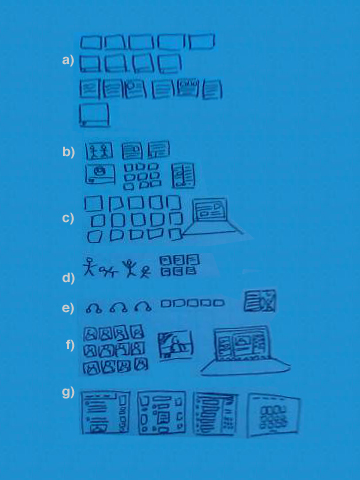 a) accionesplasticas.comb) mayatalk.wordpress.com/2007/04/11/obsessed-with-frida-kahlo/c) thewayismadebywalking.com/d) www.youtube.com/watch?v=V5sFV2xmpfAe) berlinseruv.comf) www.youtube.com/watch?v=359HwupsY1sg) mayaescobar.com
a) accionesplasticas.comb) mayatalk.wordpress.com/2007/04/11/obsessed-with-frida-kahlo/c) thewayismadebywalking.com/d) www.youtube.com/watch?v=V5sFV2xmpfAe) berlinseruv.comf) www.youtube.com/watch?v=359HwupsY1sg) mayaescobar.com
Washington University in St. Louis MFA Open Studios
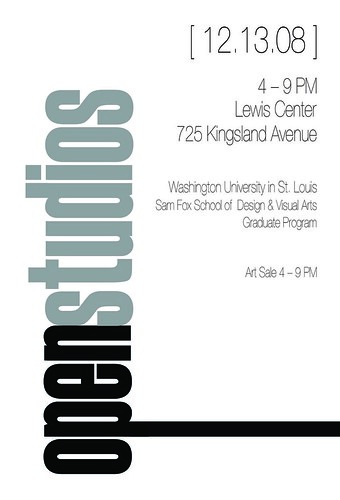 Washington University Graduate Open Studios and Art Sale Saturday, December 13th, 2008 Open Studios: 4-9 p.m. Lewis Center725 Kingsland_____________________________________________________________________Washington University MFA students are pleased to announce our Fall 2008 Open Studios and Art Sale, featuring work by more than 40 innovative young artists working in painting, printmaking, photography, sculpture, combined media, installation and video.From 4-9 our studios will be open to the public and artists will be present to answer questions and interact with visitors. This event presents a unique opportunity to experience the work of emerging artists outside the traditional gallery setting. The event will be accompanied by an art sale from 4-9:00 pm.The art sale will take place on the third floor of the MFA Building and will feature original works by MFA students. Payments may be made in cash, or by check with ID only. Proceeds will benefit the Washington MFA Student Organization and will be put towards the growth and development of the MFA program as well as to the individual artist.The Graduate Program has been flourishing at Washington University. Housed in the distinctive Lewis Center in the heart of University City, MFA students and faculty interact in a collaborative, organic setting, creating a program that is always evolving and pushing the boundaries of contemporary artistic practice. Please join us for this unique event.
Washington University Graduate Open Studios and Art Sale Saturday, December 13th, 2008 Open Studios: 4-9 p.m. Lewis Center725 Kingsland_____________________________________________________________________Washington University MFA students are pleased to announce our Fall 2008 Open Studios and Art Sale, featuring work by more than 40 innovative young artists working in painting, printmaking, photography, sculpture, combined media, installation and video.From 4-9 our studios will be open to the public and artists will be present to answer questions and interact with visitors. This event presents a unique opportunity to experience the work of emerging artists outside the traditional gallery setting. The event will be accompanied by an art sale from 4-9:00 pm.The art sale will take place on the third floor of the MFA Building and will feature original works by MFA students. Payments may be made in cash, or by check with ID only. Proceeds will benefit the Washington MFA Student Organization and will be put towards the growth and development of the MFA program as well as to the individual artist.The Graduate Program has been flourishing at Washington University. Housed in the distinctive Lewis Center in the heart of University City, MFA students and faculty interact in a collaborative, organic setting, creating a program that is always evolving and pushing the boundaries of contemporary artistic practice. Please join us for this unique event.
Berlin's Eruv
Talented Female Artists: Eleanor Dubinsky

Eleanor Dubinsky is a musician, choreographer, video and visual artist whose performances and installations create the experience of travel and a sense of immersion in the unknown. Eleanor's work embraces and inspires imagination and explores our connections to our bodies and to one another. She is interested in expanding who gets to participate in art-making and wants to engage audience members in a sense of wonder, questioning and creativity about their everyday lives. To this end, she rehearses, installs and performs her pieces in public spaces such as train and subway stations, parks and storefront windows. Eleanor’s artistic roots are in music, beginning with classical cello at the age of three. Based in New York since 1999, she has performed and created in France, Poland, the Czech Republic, Argentina and throughout the United States.
be sure check out her myspace page to hear her awesome music...[youtube=http://uk.youtube.com/watch?v=yycdvyycBx4]
Get on the Guagua
coming soon....Eleanor's pieces Fast Body (2007) and Get on the Guagua: a film about getting on the bus and around in general in Havana, Cuba (2006) were selected for the Danca em Foco International Videodance Showing in 2008, which will take place from August 7-24th at Oi Futuro, Rua Dois de Dezembro, 63/4º andar – Flamengo – Rio de Janeiro, Brazil. www.dancaemfoco.com.brEleanor will be in Turkey from July 12-29 participating in a week-long intensive workshop in music and dance improvisation with master teachers Julyen Hamilton and Barre Phillips, followed by a week-long performance residency in Cappadocia with the Paris-based dance and music collective Emma Jupe, of which she is a member. They will be developing and performing new work and performing daily for the local residents in public spaces.
ARTE ≠ VIDA: ACTIONS BY ARTISTS OF THE AMERICAS
Last weekend Carianne and I went to NY for the 2008 Whitney Biennial. As we expected from a survey of Contemporary American Art, not everything in the exhibition appealed to us. However neither of us was disappointed because we were not expecting to be unilaterally wowed. Upon leaving the Whitney, we got into an in-depth discussion about individuals' preconceived expectations, and the role they play in the determining interaction/interpretation/enjoyment, with actual works of art. Soon after this conversation, I was put to the test. As any young MFA student (traveling to New York) who has any hopes of some day having a career, Carianne and I were preparing to leave our hotel, to visit the elusive Chelsea Galleries, when I came upon an announcement for a show at El Museo Del Barrio, ARTE ≠ VIDA: ACTIONS BY ARTISTS OF THE AMERICAS
“Arte no es vida” surveys, for the first time ever, the vast array of performative actions created over the last half century by Latino artists in the United States and by artists working in Puerto Rico, the Dominican Republic, Cuba, Mexico, Central and South America.
Many of the works included in Arte ≠ Vida have subtle or overt political contexts and content: military dictatorships, civil wars, disappearances, invasions, brutality, censorship, civil rights struggles, immigration issues, discrimination, and economic woes have troubled the artists’ homelands continuously over the past four decades and therefore have infiltrated their consciousness. According to curator Deborah Cullen, “the exhibition title challenges the commonplace idea that art is equivalent to life, and life is art. What is proposed through these many works is that while art affirms and celebrates life with a regenerative force, and sharpens and provokes our critical senses, artistic actions which address inequalities and conflict are not equivalent to real life endured under actual repression.”
Over 75 artists and collectives are represented in Arte ≠ Vida, including ASCO, Tania Bruguera, CADA, Lygia Clark, Papo Colo, Juan Downey, Rafael Ferrer, Guillermo Gómez-Peña, Alberto Greco, Alfredo Jaar, Tony Labat, Ana Mendieta, Marta Minujin, Raphael Montañez-Ortiz, Hélio Oiticica, Tunga and contemporary practitioners including Francis Alÿs, Coco Fusco, Regina José Galindo, Teresa Margolles and Santiago Sierra. The exhibition is arranged in four major sections, in which each decade is represented by several specific themes that often cross national boundaries. 1960-1970 looks at select precursors, signaling, destructivism and neoconcretismo; 1970-1980 considers political protest, class struggle, happenings, land/body relationships and border crossing; 1980-1990 focuses upon anti-dictatorship protest and dreamscapes; and 1990-2000 references the Quincentenary, multiculturalism, postmodernism and endurance. An additional section highlights interventions that artists have carried out on television over the past 20 years. In these chronological, thematic groupings, viewers will be able to explore the interconnections among various artists’ actions as well as the surges of activities triggered by specific events in certain countries.
I didn't know what to do. This sounded to good to be true, but we also knew we were supposed to visit the Chelsea Galleries. I considered just buying the catalogue to the exhibition and skipping the show. I don't know if it was faith or instinct that got us there, but I can say with out any doubt in my mind that this was single handedly the best exhibition I have ever attended.
"¿Quién puede olvidar las huellas?," Regina Galindo. 2003.
Galindo walking through the streets of downtown Guatemala City, wetting her feet in a blood-filled bucket, and leaving a path of footprints from the Constitutional Court building to the Presidential Palace, where she was welcomed by a police battalion. The Court had just validated former dictator Efraín Ríos Montt, the country’s foremost author of genocide, as a presidential candidate.
[youtube="http://uk.youtube.com/watch?v=D46p71QdCTc"]

Oscar Bony (1941-2002) hired a working-class family at twice their going wage to pose in a Buenos Aires gallery as a living work of art
[youtube=http://uk.youtube.com/watch?v=8N5xbLtokZY]
"Arte Reembolso/Art Rebate" by Elizabeth Sisco, Louis Hock and David Avalos. 1993.


[...] "The current economic recession has been debilitating for many artists regardless of the content of their work. Since this climate is characterized by a particular hostility toward controversial art, it is especially significant that Elizabeth Sisco. Louis Hock. and David Avalos have maintained a reputation for causing trouble in San Diego. Their collaborative public art projects receive scandalous reports in local and national news media and are often used as examples of the National Endowment for the Art' inadequate standards of quality. Their most current collaborative project Art Rebate (1993) refunded $10 bills to 450 undocumented workers along the San Diego, California/Mexico border. It was commissioned by the Museum of Contemporary Art, San Diego and Centro Cultural de la Raza as part of the "La Frontera/The Border" exhibition. In response to recent attention to border relations due to NAFTA and other government policies, the artists wished to refute the popular misconception that undocumented Mexican workers do not pay taxes as well as demonstrate. albeit with a small symbolic gesture, their appreciation of the undocumented as valued members of Western states, communities. Furthermore, I believe their work has significant implications for undocumented workers from other nations, residing in other regions of the United States - Caribbean workers in Florida and New York City, for example. If the communities in which the undocumented workers from these areas work and reside could also acknowledge their common contributions, in the form of taxes among other things, then perhaps we as a society could also begin to address the crimes inflicted upon these groups and apply our democratic notions of human rights to those within our national borders. [...]
"The projects are clearly controversial. That's not an accident. It's not as if someone latches onto the projects and holds them up as problematic. We intend to create something that is provocative and engenders a public discussion. It is public art, not art in the public. The work is defined by its performance in the community. The public discussion is crucial to the project. In order to begin a discussion we initiate an action - for example, a bus poster or a $10 rebate - that starts the ball rolling. We definitely aim to draw in the broadest spectrum of people, including those in power for the discussion. Obviously the media is not a neutral mechanism for communicating the events that unfold during the projects: it has an agenda that shapes its participation in the discussion. For example, much of the language used to describe Art Rebate in the press was the same inflammatory rhetoric promoted and laid out by the politicians who had given a profile of blame to the undocumented. Similarly, the press had a hard time imagining, and therefore was unable to fairly convey, the undocumented as taxpayers. The press was invited to experience the act of rebating these signed $10 bills. They were encouraged to ask the opinion of undocumented workers concerning their status as taxpayers, but the responses failed to appear prominently in the news media. The media coverage was not a means of evaluating the project but rather a component of the project. Their viewpoints describe a conceptual social space in which they situate the taxpayer and the undocumented in different realms."
"The Parthenon of Books/Homage to Democracy, Buenos Aires," Marta Minujín. 1983.
In December 1983 the Argentine Conceptual artist Marta Minujin and a group of helpers spent 17 days building a full-scale model of the Parthenon in a public park in Buenos Aires, Roberta Smith writes. Except for a metal scaffolding, it was made almost entirely of books wrapped in plastic. All the books had been banned by one of the most oppressive juntas in the country’s history, which was just being dismantled after Argentina’s first democratic election in a decade. “The Parthenon of Books/Homage to Democracy,” as Ms. Minujin’s work was titled, stood for about three weeks. Then the public was allowed to disassemble the piece and keep the books.
partenon de libros marta minujinAvenida 9 deJulio y Avenida Santa Fe. Buenos Aires. Argentina. Concebida como un monumento a la democracia y a la educación por el arte, Partenón constaba una estructura metálica, réplica del partenón, recubierta con prohibidos durante la dictadura militar.


[...]In a similar fashion to the live human spectacles of the past, Fusco and Gomez-Peña performed the role of cultural "other" for their museum audiences. While on display the artists' "traditional" daily rituals ranged from sewing voodoo dolls, to lifting weights to watching television to working on laptop computers. During feeding time museum guards passed bananas to the artists and when the couple needed to use the bathroom they were escorted from their cage on leashes. For a small donation, Fusco could be persuaded to dance (to rap music) or both performers would pose for Polaroids. Signs assured the visitors that the Guatinauis "were a jovial and playful race, with a genuine affection for the debris of Western industrialized popular culture . . . Both of the Guatinauis are quite affectionate in the cage, seemingly uninhibited in their physical and sexual habits despite the presence of an audience." Two museum guards from local institutions stood by the cage and supplied the inquisitive visitor with additional (equally fictitious) information about the couple. An encyclopedic-looking map of the Gulf of Mexico, for instance, showed the supposed geographic location of their island. Using maps, guides, and the ambiguous museum jargon, Fusco and Gomez-Peña employed the common vocabulary of the museum world to stage their own display[...]
"Construction of a Traditional Rural Oven,'' Víctor Grippo y Jorge Gamarra. 1972.
CONSTRUCCION DE UN HORNO POPULAR PARA HACER PAN
Intención: Trasladar un objeto conocido en un determinado entorno y por determinada gente, a otro entorno transitado por otro tipo de personas.Objeto: Revalorizar un elemento de uso cotidiano, lo que implica, además del aspecto constructivo escultórico, una actitud.Acción:a) Construcción del Hornob) Fabricación del Panc) Partición del Pan.Resultante pedagógica: Describir el proceso de construcción del Horno y de la fabricación del Pan. Distribuir una hoja. Será posible la participación del público mediante un intercambio de información.
"Untitled (Body Tracks),'' Ana Mendieta. 1974.

Gina Grafos
beauty, brains, talent, wit... she has got it all.my girl Gina Grafos will be featured on the front cover of zeek magazine's april additon.be sure to check her out.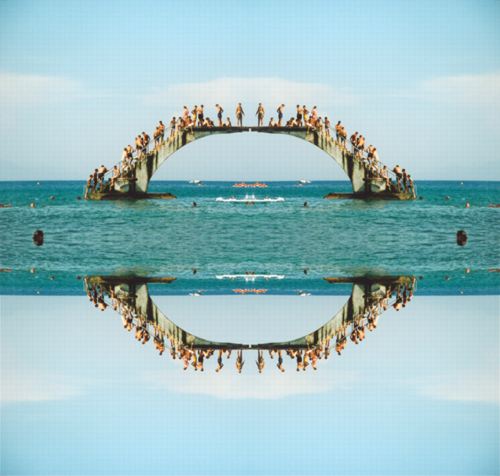
Birth. Soul. Spirit. Death. All cycles of life are overlapped in Gina Grafos' life and in work. Raised in a Jewish, evangelical Christian, Greek Orthodox family, Grafos' perception of belief was left quite askew. Her work now deals with the beliefs of others, with a preference for representations of faith whether relgious or philosophical.
abidin travels
 (above)Willie Cole, The Difference between Black and White,2005-6. Shoes, wood, metal, screws, and staples, 85 x 16".
(above)Willie Cole, The Difference between Black and White,2005-6. Shoes, wood, metal, screws, and staples, 85 x 16".
ST. LOUIS, MO - War and disaster have profoundly shaped the opening years of the 21st century. In the United States and abroad, acts of violence and terrorism as well as natural catastrophes have resulted in large-scale destruction and displacement affecting the lives of millions. In February, the Mildred Lane Kemper Art Museum at Washington University in St. Louis will present On the Margins, an exhibition exploring the impact of war and disaster through the work of a diverse range of contemporary artists. Curated by Carmon Colangelo — a nationally known printmaker as well as dean of the university's Sam Fox School of Design & Visual Arts — the exhibition will showcase more than a dozen works, ranging from prints and photographs to video and large-scale installations, by ten artists from around the world. Several installations play against traditional approaches to war memorial. For example, Fallen (2004-ongoing), by the American artist Jane Hammond, comprises a large field of brightly colored leaves, each bearing the name of a soldier killed in Iraq. Similarly elegiac is Metal Jacket (1992/2001), by South Korea's Do-Ho Suh, which consists of 3000 dog tags stitched to the liner of a U.S. military jacket. Abidin Travels: Welcome to Baghdad (2006), an interactive video installation by the Iraqi expatriate Adel Abidin, allows viewers to become virtual tourists amidst the wreckage of his native Baghdad.
In conjunction with the exhibition MFA candidates Carianne Noga, Dan Solberg, Erica Millspaugh and I assumed the role of travel agents assisting museum visitors in arranging their virtual flight Baghdad aboard a B52.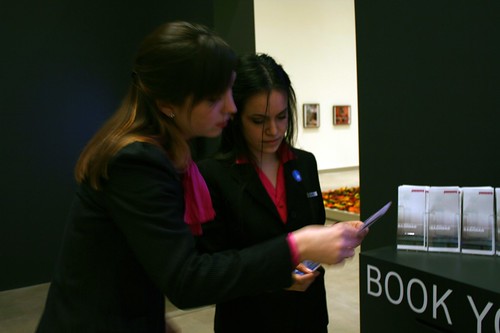
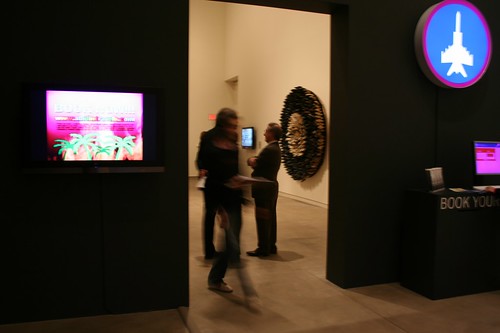

Bitch Magazine
Acciones Plásticas was discussed in current issue of Bitch Magazine Lost and Found #38. The article is entitled The Princess Diaries: In an Age of Ostentation the J.A.P. is Back written by Julia Appel, a rabbinical student at Hebrew College.To view the full article (pdf version) click here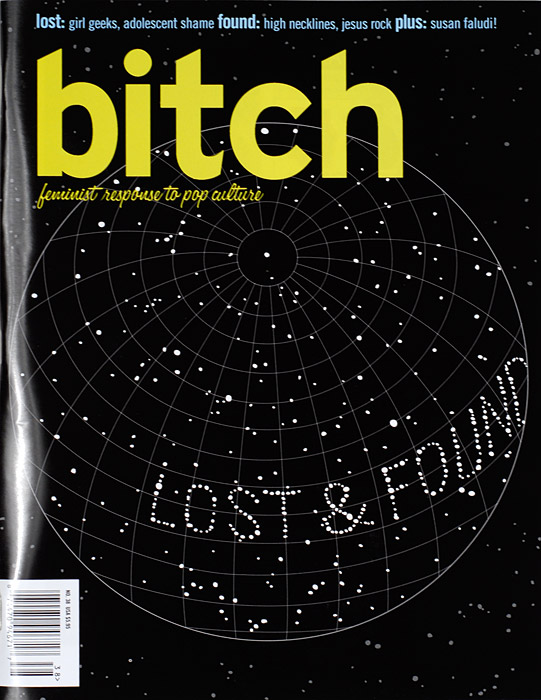
One blogger on Jewschool questioned the artistic success of a new piece by a performance artist named Maya Escobar entitled Acciones Plasticas (Plastic Dolls), in which the artist impersonates in short video segments various stereotypes that make up her identity. Her send-up of the J.A.P. was familiar to me from my years spent in a heavily Jewish, upper-middle-class suburb of Boston. Escobar's J.A.P. flips her straight dark hair and fiddles with her silver jewelry as she talks insipidly about her high-school popularity and rejection of male suitors. The blogger wrote by way of illustration, "She...nails the J.A.P. with a monologue so infuriatingly vapid and unaware it's as excruciating as the real-life experience."

[...]Using the Jewish American Princess in a deadpan manner can result in a sophisticated social critique that reveals how ridiculous the stereotype itself. The key is absurdity: Take Sarah Silverman, who frequently conjures the J.A.P. in her comedy, with mixed results [...] Maya Escobar's piece also falls in this category: by contextualizing the character in her video as a "doll" she reveals how ridiculous it is to take the character seriously. But what about the less-successful attempts at deploying the term? The reason "J.A. P." is ripe for reclamation is because it stands at the border between resonantly hateful and outdated. Although not as widely used as it once was, it still packs a punch. Therefore, if the context is not skillfully executed, the attempt serves not to interrogate or reclaim, but rather only to perpetuate the myth[...]
Producto? Inc
UPDATEBraulio was featured on artnet.com Artist Alfi Rolón performing as part of Braulio Espinosa Castillo’s "Artistas de Hoy"
Artist Alfi Rolón performing as part of Braulio Espinosa Castillo’s "Artistas de Hoy"
Circa ’07 also featured a row of smaller booths housing individual projects by invited artists. One of the most popular was "Artistas de Hoy," a project stage-managed by Braulio Espinosa Castillo of Producto? Inc., for which he somehow convinced 40 artists to pose in a glass display case alongside a video of their artwork. The combination was a perfect gambit. Not only were the videos illuminating, but fair visitors clearly were enchanted by the opportunity to stare at real artists standing in a booth.
Producto? Inc. es una propuesta que nace de la reflexión en torno a la condición "natural" del individuo como producto mercantil. Con la dirección de Braulio Espinosa Castillo y la colaboración incondicional de familiares, amigos, colegas artistas y auspiciadores.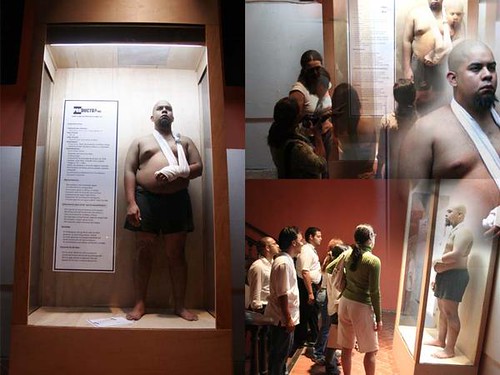
El proceso de cosificación que produce la sociedad de consumo a la que nos enfrentamos a diario no se limita solo a la materia no viviente y no pensante, sino también a los seres humanos: mercaderes y consumidores. Siempre el hombre ha puesto algún tipo de valor sobre la materia, sea viva o no. Un producto mercantil es una cosa producida con la finalidad de la venta. En el contexto actual de vida somos un producto mercantil, primero por que somos una cosa producida. Producida por el hogar, la iglesia, las escuelas, la universidad, los trabajos. Segundo, mientras no exista otro sistema económico, todos cambiaremos dinero por nuestro servicio; trabajo y conocimiento. El salario mide el precio del trabajo, que a fin de cuenta, define el valor material del trabajador, el producto. En algunos países el acto es aún más literal, cuando se venden esclavos, niños y órganos humanos.
En CIRCA 07 estarán participando 40 colegas artistas, cada uno con su propuesta individual de ellos mismos como producto mercantil. Durante 25 minutos estarán en exhibición, en instalación-performace.
